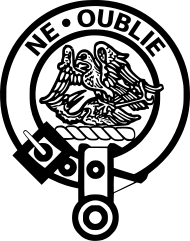| Clan Graham | |||
|---|---|---|---|
| Greumaich nan cearc (Highland Grahams only) [1] | |||
 Crest: A falcon Proper, beaked and armed Or, killing a stork Argent, Armed Gules | |||
| Motto | Ne oublie (Do Not Forget) [2] | ||
| Profile | |||
| District | Loch Katrine, Perthshire, Dundee and Montrose [2] | ||
| Plant badge | Laurel [2] | ||
| Pipe music | Killiecrankie [2] | ||
| Chief | |||
 | |||
| The Most Noble James | |||
| The 8th Duke of Montrose (An Greumach Mòr) | |||
| Seat | Buchanan Castle [3] | ||
| Historic seat | Mugdock Castle [3] | ||
| |||
| |||
| |||
| |||
Clan Graham (Greumaich nan Cearc [ˈkɾʲeːmɪçnəŋʲˈkʲaɾʃc] ) has two main families of Scottish clans, the Grahams of Menteith (descended from the Earl Of Menteith) and the Grahams of Montrose (descended from the Duke of Montrose). Each have their own tartan patterns. William Graham became the 7th Earl of Menteith in 1610 in what is now Perthshire, Scotland. The Grahams of Montrose had territories in both the Scottish Highlands and Lowlands, and the chief of the clan rose to become the Marquess and later Duke of Montrose.



